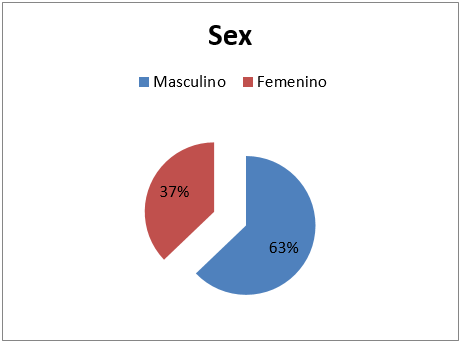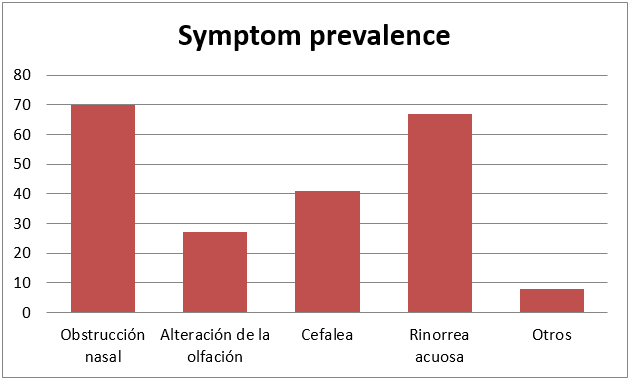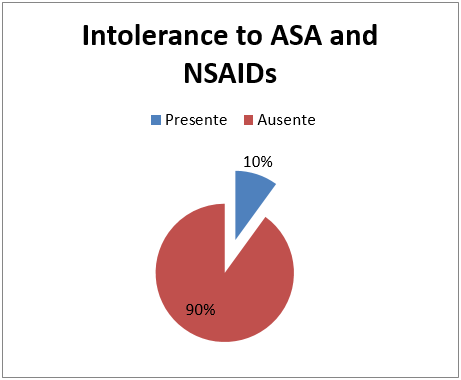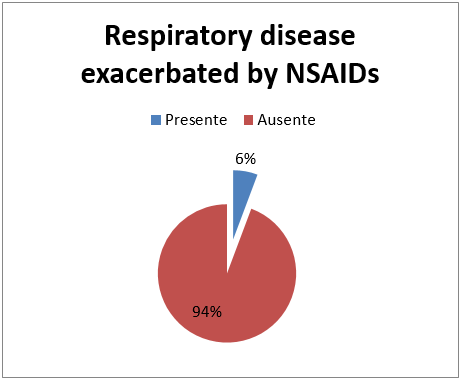Research Article
Volume 3 Issue 1 - 2021
NSAID-Exacerbated Respiratory Disease in Patients with Nasosinusal Polyposis in the Othorhynolaringology service at Hospital de Clinicas, Paraguay, from January, 2016 to June, 2020.
Dr. Candia 1051, Asunción-Paraguay, Affiliation: Facultad de Ciencias Médicas, Universidad Nacional de Asunción (FCM-UNA)
*Corresponding Author: Carlos Mena Canata, Dr. Candia 1051, Asunción-Paraguay, Affiliation: Facultad de Ciencias Médicas, Universidad Nacional de Asunción (FCM-UNA).
Received: February 07, 2021; Published: February 18, 2021
Abstract
Nasosinusal polyposis is a chronic inflammatory disease of the mucosa of the ethmoid sinuses, appearing mostly as bilateral polypoid lesions. On the other hand, NSAID- Exacerbated respiratory disease (NERD, also known as Widal’s triad) includes this pathology, as well as asthma and intolerance to aspirin and/or NSAIDs. Here, we determined that the prevalence of NERD is only 6% of the patients in the study (n = 70), with no predominant sex. Furthermore, a higher prevalence of nasosinusal polyps was found in male patients (63%), with an average near 40 years old. The most common symptom is nasal obstruction, followed by watery rhinorrhea and headache. The presence of polyps was confirmed to be bilateral in most cases, being 6% unilateral. This is the first study carried out in Paraguay on the prevalence of this disease, which will lay the foundations for future research.
Introduction
Sinonasal polyposis (SNP) is an inflammatory disease of the mucosa that covers the lateral masses of the ethmoid, characterized by the appearance of smooth, gelatinous, translucent, and pyriform polypoid lesions. These begin their growth in the ethmoid and proliferate, expanding into the nostrils. [1–3] It is a chronic, insidious, benign process that never degenerates, with a bilateral nature that tends to recur after treatment. [3,4]
SNP can be associated with different systemic diseases including cystic fibrosis, asthma and diseases of ciliary mobility among others and can also accompany different local entities such as rhinitis or chronic rhinosinusitis. [5] However, most patients with nasal polyps are affected by inflammatory disease of the sinus mucosa. [1,2] Its etiology is still controversial, and the theories currently studied are: allergic, infectious, genetic and inflammatory. [6]
The incidence of this pathology is not exactly known, according to data published in the United States, it is between 2% and 5% of the general population. It affects men more frequently than women, and it usually appears in the middle age of life, being infrequent in childhood. [7]
Widal syndrome, also known as “Samter's triad” or ASA triad, was described in 1922. Currently, an international consensus has been reached to refer to it as a respiratory disease exacerbated by NSAIDs (NERD). (8) This is characterized by sinonasal polyposis, asthma, and intolerance to aspirin and/or NSAIDs. [9] Numerous authors report a highly varied prevalence, with a wide range ranging from 8% to even 70.8% of people with PNS. [5.9]. In addition, 26.1 to 45% of PNS carriers suffer from asthma and between 10 to 30% of intolerance to NSAIDs and / or aspirin. [1.4]
Currently, in Paraguay there are no studies of the prevalence of NERD, so the following work will serve to lay the foundations for this and provide data for further research.
Overall objective
- To determine the prevalence of Widal's triad in patients with sinonasal polyposis in the Otorhinolaryngology service of the Hospital de Clínicas from January 2016 to June 2020.
Specific objectives
- Identify sociodemographic characteristics of patients operated on for sinonasal polyposis in the service from January 2016 to June 2020.
- Identify the most common symptoms that patients presented.
- Classify the degree of polyposis endoscopically according to Lildholdt.
- To determine the frequency of association with asthma, intolerance to NSAIDs and/or aspirin in patients with PNS undergoing FESS.
Materials and Methods
The present study was descriptive observational, retrospective cross-sectional. The data were collected through the clinical records of post-operated patients for nasal polyposis in the Otorhinolaryngology service of the Hospital de Clínicas for the period 2016-2020.
The target population comprised patients with a diagnosis of sinonasal polyposis from the otorhinolaryngology service of the Hospital de Clínicas, considering this as an inclusion criterion. Those who had complete records and underwent surgery in the 2016-2020 period were the accessible population, taking as exclusion criteria those who did not undergo surgery and those who did not have complete records.
The sampling was non-probabilistic of consecutive cases. The variables analyzed were the sociodemographic characteristics of the patients, the symptoms they presented, the degree of polyposis according to Lildholdt, the association they presented with asthma, intolerance to NSAIDs and/or ASA and NERD.
The data was stored and analyzed in Microsoft Excel 2010.
Regarding ethical issues; this study did not represent a risk to the physical and mental integrity of the participants, and their anonymity was respected.
The principles of bioethics, beneficence, non-maleficence, justice and autonomy were respected.
This work was funded by the authors, who declare that they have no conflict of interest.
Results
Seventy post-operated sinonasal polyposis patients participated in the study, of which 44 (63%) were men and 26 (37%) were women (Figure 1). The average age was 39 years for males and 36 years for females. (Table 1)
100% of the patients presented nasal obstruction, 39% altered olfaction, 96% watery rhinorrhea, 59% headache, 7% auditory symptoms, and 4% epistaxis. (Figure 2)
According to the Lildholdt classification, 37.1% (26) have severe polyposis in the right nostril, 34.2% (24) moderate, 25.7% (18) mild, and 2.8% (2) absence of polyps. On the left side, severe in 30% (21) of the patients, moderate in 44.2% (31), mild in 22.8% (16) and 2.8% (2) absence of polyps. (Table 2)
Regarding the association with other pathologies, 14% also had a diagnosis of asthma (Figure 3) and 7% had intolerance to NSAIDs or ASA (Figure 4). It could be seen that only 6% of those studied had NERD, without seeing a predominance of sex. (Figure 5)

Figure 1: Distribution by sex of sinonasal polyposis in post-operated sinonasal polyposis patients of the HC-SL otorhinolaryngology service.
| Sex | Average age |
| Female | 36 |
| Male | 39 |
Table 1: Average age according to sex.
| Lildholdt Classification | Right | % | Left | % | |
| Absence of polyps | 2 | 2,8 | 2 | 2,8 | |
| Mild | 18 | 25,7 | 16 | 22,9 | |
| Moderate | 24 | 34,3 | 31 | 44,3 | |
| Severe | 26 | 37,1 | 21 | 30 |
Table 2: Severity of sinonasal polyposis according to the Lildholdt classification.
Discussion
Nasal polyposis is defined as nasal and paranasal sinus obstruction caused by an inflammatory degeneration in them, of which a prevalence of between 2 to 5% is estimated in various studies. Both sexes are usually affected, with a higher prevalence in men in the fourth decade of life and exceptionally in children under 10 years of age. This finding is similar to those obtained in our study, where it was found that the majority of nasal polyposis occurred in men with an average age of 39 years [1–3, 10].
Regarding the symptoms, all the literature and studies reviewed, as well as in our analysis, it was confirmed that 100% of the patients during the course of the disease presented nasal obstruction.
PNS, according to different studies, is associated with asthma in 7 to 45% of cases, data that coincide with the findings in our study (14%), 10 to 30% of cases present intolerance to NSAIDs and/or o ASA [1,2,4,5], a figure higher than that found (7%) and numerous authors report a highly varied prevalence, with a wide range that goes from 2 to even 70.8% of patients with Widal's triad, being this more frequent in the female sex and presenting a more severe symptomatology. In our analysis, only 6% of those studied presented Widal's triad, not finding a predominance of sex, but the severity of the symptoms was confirmed by the Lildholdt classification. [8, 10-14]
Conclusion
In this study, a higher prevalence of sinonasal polyposis was observed in men with an average age of 39 years.
It was noted that all the patients presented nasal obstruction as symptoms, followed by watery rhinorrhea, headache and alteration of olfaction.
In the right nostril, most of the polyposis were severe according to the Lildholdt classification and in the left, moderate.
It was seen that the association of SPN with other pathologies, especially with NERD, is found in the minority of patients.
References
- Fernández Pascual E, Lopez M, Ruiz Gomez M, Fernandez P. Poliposis nasosinusal. En: Libro virtual de formación en ORL. España: SEORL PCF.
- Bonfils P. (2012). Poliposis nasosinusal. EMC - Otorrinolaringol. febrero de 41(1): 1-25.
- Basterra Alegría J. Tratado de otorrinolaringología y patología cervicofacial [Internet]. 3° Edición. Barcelona, España: Elsevier; 2009 [citado 16 de agosto de 2020]. 372-378 p.
- Dessi P, Facon F. (2004). Poliposis nasosinusal del adulto. EMC - Otorrinolaringol. 33(1):1-17.
- Fajardo Dolci G, Gutiérrez Marcos JÁ, Gutiérrez Marcos LM.( 2000). Poliposis nasal. Médica Sur, México. Setiembre de 7(3):106-9.
- Díaz V, Carías A, García J. (2019). Poliposis nasosinusal. Rev Fac Cienc Méd. junio de 16: 29-33.
- Toledano Muñoz A, Herráiz Puchol C, Navas Molinero C, García Simal M, Navarro Cunchillos M, Galindo Campillo AN. (2008). Estudio epidemiológico en pacientes con poliposis nasal. Acta Otorrinolaringológica Esp. 1 de noviembre de 59(9): 438-43.
- Arcos MBA. (2019). EREA: La enfermedad respiratoria exacerbada por aspirina.22: 7.
- Gajardo O P, Fonseca A X. (2009). Intolerancia a la aspirina en pacientes con poliposis nasal y asma bronquial. Rev Otorrinolaringol Cir Cabeza Cuello [Internet]. agosto de [citado 16 de agosto de 2020];69(2).
- Publicación Científica del Hospital Británico de Buenos Aires. Epidemiología de la poliposis nasal. marzo de (2018) 13(1):18-21.
- Hao J, Pang YT, Wang DY. (2006). Diffuse Mucosal Infl ammation in Nasal Polyps and Adjacent Middle Turbinate. Otolaryngol Head Neck Surg 134: 267-75.
- Assanasen P, Naclerio RM. (2001). Medical and surgical Management of nasal polyps. Curr Opin Otolaryngol Head Neck Surg 9: 27-36.
- Rajan JP, Wineinger NE, Stevenson DD, White AA. (2015). Prevalence of aspirin-exacerbated respiratory disease among asthmatic patients: A meta-analysis of the literature. J Allergy Clin Immunol. 135(3): 676-681.
- Hernández-Moreno Karen Estefanía, Cardona Ricardo. Enfermedad respiratoria exacerbada por aspirina. Revisión a partir de casos clínicos. Rev. alerg. Méx. [revista en la Internet]. 2018 Mar [citado (2021) Feb 02]; 65(1): 78-91
Citation: Dra. Adriana García, Prof. Dr. Carlos Mena, Prof. Dr. Enrique Pérez. (2021). NSAID-Exacerbated Respiratory Disease in Patients with Nasosinusal Polyposis in the Othorhynolaringology service at Hospital de Clinicas, Paraguay, from January, 2016 to June, 2020. Journal of Otolaryngology - Head and Neck Diseases 3(1). DOI: 10.5281/zenodo.4563949
Copyright: © 2021 Carlos Mena Canata. This is an open-access article distributed under the terms of the Creative Commons Attribution License, which permits unrestricted use, distribution, and reproduction in any medium, provided the original author and source are credited.




